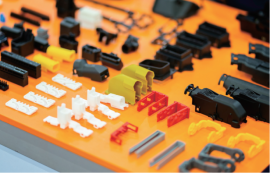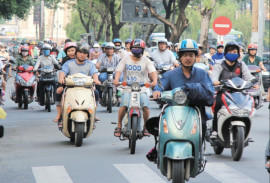In the process of industrialization and modernization, the automobile industry is one of the leading industries in the economy and plays an important role in the economic development of the nation. In Vietnam, the automobile industry has always been an area of government interest and investment encouragement. Thanks to this, Vietnam's automobile industry has developed significantly over the past few years, with an increase in domestic production and assembly as well as local procurement rates. However, while there are opportunities, there are also many challenges facing Vietnam's automobile industry. This article delves into Vietnam's automobile industry.

Automobile production and assembly in Vietnam
In 2022, the number of automobiles assembled in Vietnam (on a design basis) is approximately 755,000 units per year, of which 35% is produced by FDI firms and 65% by domestic firms.
Truong Hai Auto (THACO), a leading automotive assembly and production company, is one of the "driving forces" behind the production and assembly of a series of Kia Motors (Korea) models in Vietnam, from the Morning compact to the Sorento midsize SUV. With its modern assembly lines, THACO also meets the requirements of its Japanese partners and assembles and supplies Mazda vehicles in the Vietnamese market. In December 2022, THACO announced the start of production of BMW's 3 Series, 5 Series, X3, and X5 models, sending shockwaves through the automotive industry. The company also continues to produce four Peugeot models (the 2008, 3008, and 5008 SUVs and the Traveller minivan).THACO's local procurement rate, especially for trucks and buses, is quite high.
Hyundai Thanh Cong Vietnam (HTC), a joint venture between South Korea's Hyundai Motor Company and Vietnamese conglomerate Thanh Cong Group, produces popular Vietnamese models such as the Grand i10, Accent, Elantra, Santa Fe, and Tucson. In November 2022, HTC started full-scale operations of its second factory at the Gian Khau Industrial Park in the northern province of Ninh Binh. The plant will have a production capacity of 100,000 units per year, bringing the combined capacity with the first plant to 180,000 units per year, with plans to add assembly of the Hyundai Creta in 2023, followed by the production of several EV models in Vietnam, including the high-profile IONIQ 5. In October 2022, TC Motor, the automotive division of Thanh Cong Group, announced a strategic partnership with Skoda Auto, the largest Czech automaker and subsidiary of Germany's Volkswagen. It plans to start selling models produced in Europe as early as 2023, and to begin CKD production of Skoda vehicles such as the KUSHAQ SUV and the SLAVIA sedan at TC Motor's new plant under construction in the northern province of Quang Ninh by the end of 2024.
Another project that attracted attention in 2022 was the announcement by GELEXIMCO, a real estate development company in Vietnam, that it plans to build an automobile manufacturing and assembly plant in Tien Hai Industrial Park in the northern province of Thai Binh in 2023. With a total investment of 7 trillion dong, construction is scheduled to begin in the first quarter of 2023, and the plant is scheduled to be completed and begin operation in the third quarter of 2024. Once operational, the plant will be one of the largest automobile manufacturing and assembly plants in Vietnam.
In February 2023, TMT Motors, a local manufacturer that produces and sells trucks, formed a strategic alliance with SGMW (中国上汽通用五菱汽車), a joint venture between General Motors (GM) of the United States, SAIC (上海汽車), a Chinese automaker, and Wuling Motors (五菱汽车), to produce, assemble, and sell electric vehicles (EV) in Vietnam. The agreement includes SGMW supplying parts to TMT and TMT exclusively assembling, producing, and selling Guling Motors' EVs in Vietnam. These EV models will be assembled at TMT's auto plant in the northern province of Hung Yen, with an expected annual production of 30,000 units.
Looking at international brands, Ford continues to assemble three strategic models, the Ranger (with over 60% share of sales in Vietnam), Territory, and Transit, at its plant in Hai Duong Province. Honda assembles two models, the City and CR-V, at its plant in Vinh Phuc Province. Toyota announced that it will switch its popular models, the Veloz Cross and Avanza Premio, from importing finished vehicles to assembling them in Vietnam starting in December 2010. Mitsubishi assembles two of its top-selling models, the Outlander and Xpander, at its plant in Binh Duong Province.
Automobile industry in the economic downturn of 2023
Despite its impressive performance in 2022, the domestic and international macroeconomic impact on Vietnam's automotive industry is profound. According to forecasts by several international organizations, global GDP growth in 2023 will decline and not reach 2022 figures, averaging about 2% (IMF forecasts 2.7%, EU 2.5%, OECD 2.2%, and Fitch Ratings 1.4%).
The Central Institute for Economic Management (CIEM) of the Ministry of Planning and Investment has presented two scenarios for Vietnam's economic growth in 2023. The first scenario is based on GDP growth of 6.47%, average CPI of 4.08%, export growth of 7.21%, and a trade surplus of USD5.64 billion. The second scenario assumes GDP growth of 6.83%, average CPI of 3.69%, export growth of 8.43%, and a trade surplus of USD 8.15 billion. These figures are much lower than the GDP growth rate for 2022 (8.02%).
With the CPI at risk of exceeding 4.5% in 2023, consumers are holding off on purchasing luxury goods such as automobiles; this trend will become more pronounced if the CPI stays high.
According to the Vietnam Automobile Manufacturers Association (VAMA) report for the January-March period of 2023, nationwide car sales totaled 70,392 units, down 22.22% from the same period in 2022 (90,506 units). This trend is causing concern that Vietnam will have difficulty maintaining last year's record of over 500,000 units sold.
On the other hand, Vietnam's automobile market is also facing fierce competition from imported vehicles. In particular, there is competition from finished vehicles imported mainly from ASEAN countries such as Thailand and Indonesia, and in the next 7-10 years from now from the member countries of the CPTPP (Comprehensive and Progressive Agreement on Trans-Pacific Partnership) and the EVFTA (EU-Vietnam Free Trade Agreement).
Along with the general impact from the macroeconomy, the small size of the home market and inability to expand production operations, low local procurement rates, and high vehicle prices remain barriers for the domestic auto industry.
The Ministry of Industry and Trade stated that automobile prices in Vietnam are double those of neighboring countries such as Thailand and Indonesia, and triple those of the U.S. and Japan. The main reasons for this are high taxes and fees and low domestic production. In addition, companies have not been able to establish cooperative or collaborative relationships with component producers or to specialize, and have not been able to form large networks of raw material and component suppliers.
Similarly, according to Ministry of Industry and Trade data, the local procurement rate for 9-seat passenger cars has not yet reached the target. Products that can be procured locally include tubes, tires, chairs, mirrors, glass, wire harnesses, batteries, and resin products, while 80-90% of alloys, aluminum alloys, resin pellets, and industrial rubber, the main raw materials for parts production, are imported. Most materials for molds are also imported. The total amount of parts and components that companies import each year for automobile production, assembly, repair, and maintenance amounts to approximately 5 billion USD.
In its "Strategy for the Development of the Vietnamese Automobile Industry by 2025 and Vision to 2035," the government has set a target of exporting 90,000 automobiles and 1 billion USD in related parts. However, this will be difficult to achieve unless promotional policies are put in place by 2023 in the short term, 2027 in the medium term, and 2035 in the long term.
Another important issue is the lack of capacity among firms in the supporting industries. Tool and die makers are small or lack the coordination to grow. Few firms manufacturing crude steel and cast parts for the automobile industry have high defect rates and are unable to meet the requirements.
In the next article, we will continue with current trends in the Vietnamese electric vehicle industry and government support policies for vehicle production enterprises.
(To be continued)




















